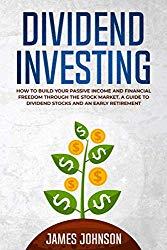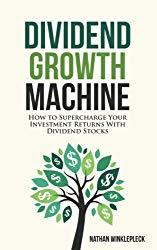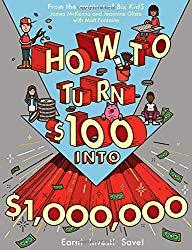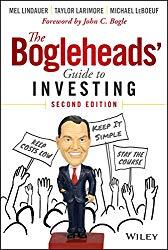There are a lot of FIRE blogger (those trying to become Financially Independent and Retire Early) who are big fans of dividends. They are building up a portfolio of dividend paying stocks and tracking their income from dividends, waiting for the day when their income from dividends equals their income from work and they can quit the rat race. Sometimes they also include some things which are income, but not exactly dividends, like bond interest, capital gains from mutual funds, rents from apartments or REITs, or distributions from Limited Partnerships. (If all of this seems confusing, do yourself a favor and pick up a copy of The SmallIvy Book of Investing, Book 1: Investing to Grow Wealthy where I explain all of these investments in detail, along with how to use them and what the risks are.) Still, all of these things are income, so it really is more of a technical misspeak than a mistake to lump them in with dividends.
(Note, if you click on a link in this post and buy something from Amazon (even if you buy something different from where the link takes you), The Small Investor will receive a small commission from your purchase. This costs you nothing extra and is the way that we at The Small Investor are repaid for our hard work, bringing you this great content. It is a win-win for both of us since it keeps great advice coming to you (for free) and helps put food on the table for us. If you don’t want to buy something from Amazon or buy a book, how about at least telling your friends and family about our website as a great place to learn about investing and personal finance. Thanks!)

If you’re new to investing, a dividend is money that a company of which you own shares pays out, usually four times a year, to you and your fellow shareholders. These are normally a few pennies to a few dollars per share. For example, if you own 100 shares of XYZ corporation and it pays a $0.36 per share dividend each quarter, you’ll receive a check four times per year for $36 or $144 per year. If the shares cost $15 each, such that your investment in XYZ is worth $1500, your return from dividends each year would be $144/$1500 = 9.6% per year, which would be a great return right now.
Sometimes a company will make a special dividend payment, for example, if they have a great quarter and want to give the shareholders a bonus. Some companies pay out a special dividend most years, meaning that your December check may be a bit bigger than the others you receive. Normally the dollars per share amount a company pays out in dividends is fairly consistent. Companies like to avoid reducing dividends. Many also like to raise the dividend each year as profits grow (and inflation makes their previous payouts a little less valuable). Dividend increases of 5-9% per year are fairly common among companies that pay dividends. This means your payout will double about every 8 to 14 years. Not bad.
There are some strategies that use dividend investing to build wealth and obtain financial freedom. To learn about them, check out Dividend Investing: How to Build Your PASSIVE INCOME and FINANCIAL FREEDOM Through the Stock Market. A Guide to Dividend Stocks and an Early Retirement


Dividends can be great.
Dividends are great for certain situations where you need income right now. If you have a portfolio full of dividend-paying stocks, REITs, and bonds, you will have money coming into your money market account that you can withdraw, write checks against, or spend with your debit card. If you’re retired you can set things up so you have money for groceries and perhaps extra income when insurance bills or property tax bills come do. A kid in college can also take advantage of a dividend portfolio to generate regular income for room and board, tuition, and other expenses.
This is all done without touching any of your stock positions. You don’t need to sell shares to get access to the money since the money comes out of the stocks automatically. If you have the actual share certificates from the company instead of leaving them in your brokerage account you’ll actually get a check from the company. (This is great for kids. If you do this, put the stock certificate in a safe deposit box so that it doesn’t get lost since you’ll need it eventually to sell the shares. To learn more about investing with kids, check out How to Turn $100 into $1,000,000: Earn! Save! Invest!

Dividends are also fairly predictable since, as previously stated, once a company sets a dividend, they try not to cut it. They will frequently increase a dividend, often annually, but they do their best not to reduce a dividend. Doing so usually indicates that they are having financial troubles, causing some investors to sell their shares. Because of this, companies usually don’t raise their dividend until they are comfortable that they are generating enough money from the business to comfortably pay out the dividend. If they aren’t certain but they have a great quarter, they may decide to pay a special dividend instead. Special dividends would not be expected to be repeated.
Because dividends are rarely decreased, you can treat them almost like regular, predictable income on your budget. (To learn how to supercharge your budget like a rich person and become financially independent, check out FIREd by Fifty: How to Create the Cash Flow You Need to Retire Early

But dividends can be bad.
Dividends are great when you need income for expenses right now. But if you don’t need the income and you’re just reinvesting the money, dividend stocks will not return as much as non-dividend paying growth stocks. Worse, dividend-paying stocks are not very tax efficient. Even when you do need the income, keeping a portion of your investments in growth stocks may still make sense for this reason.
Why dividend-paying (income) stocks lose to growth stocks
A company is like a person. Early in it’s life it is evolving, learning, and growing. Somethings work out, other’s don’t. Management (hopefully) learns from the mistakes, expands upon what works and stops doing what doesn’t. Stocks in this young phase of their lives need all of the money they can get to fund research, buy new equipment, and generally expand their business. They might be like a restaurant where they’re adding locations, or they may just be getting more customers in different locations or adding business lines. Little companies may operate at one location or in one city or one state and have one or two lines.
Because they are small, they are able to double their revenues easily. A successful chicken restaurant might be able to double their revenues and their profits by just opening up another location a few miles away. When a company doubles profits, they normally become twice as valuable and their share price doubles. Each time they do this, their share price doubles and shareholders double their investment.
Like a small child, however, they are weak and need protection. A flu that a healthy adult would just get over in a week can kill an infant. Likewise, a financial malady that hits at the wrong time can kill a small company. If a recession hits, they may need to close their doors because they don’t have money in the bank or assets they can sell. The CEO may not even be drawing a salary for a startup company and they may have huge amounts of debt. They also need to be doing everything right since they can’t take many setbacks. If one happens, the founders will often just close the doors and try again with something else.
Large companies may operate in virtually every country in the world and make thousands of different products in dozens of divisions. They are strong and well-established, perhaps having the ability to sell things with their logo on them and make money. Everybody knows their name and their products. If a recession comes, they can just close down divisions that aren’t doing well or even just ramp back on production and survive the storm.
Because they are growing faster, small growth companies – those that don’t tend to pay dividends – can increase in value much faster than large companies. Think of how many more Cokes Coca-Cola would need to sell to double their revenues. Now think how what a small number of burritos a food truck that sets up outside your work would need to sell to double their business. There’s no comparison.
Each time a company doubles their income, their share price would tend to follow. This is because, even if they aren’t paying dividends right now, the more money they are making, the bigger a dividend they could pay in the future. A small stock can easily go from $10 per share to $1000 per share within five or ten years. A large company might double in price over that time period.
What kinds of returns are we talking about here?
With a portfolio of large, established companies – the kind that are going to be paying out dividends – you can expect to get returns in the 5-8% range before inflation. This may be 2-3% in dividends and then 3-5% in capital appreciation (the stock price going up). Over a 30-year period, you’ll double your money about 2 to 3 times with such an investment. $100,000 will grow to $400,000 to $800,000 during that period. Not bad.
With a portfolio of smallish growth companies ( not the startups talked about before, but not yet household names), you might get an annualized return of 10-15% per year or more. This means you’d double your money 4 to 6 times over the same 30-year period. This means $100,000 would grow to $1.6M to $12.8M over the same period. If you are investing money that you don’t need for thirty years in dividend paying stocks and reinvesting the dividends, these are the kinds of returns you might be giving up.
Over short periods of time, like 1-10 years, it is a toss-up on which portfolio would do better. Sometimes large, multinational companies lead the way and outperform small companies. Other times small companies rally. If there is a recession, a portfolio of small stocks may drop by 50-80%. One of large dividend paying stocks may only fall by 20-40% over the same period since they are able to withstand the recession better. Plus, they are paying out that great dividend.
Dealing with the risk.
Now, just because a small company can double their revenues and double in price easily doesn’t mean that all will do so. As said before, these are fragile like little infants. If they misread the markets, they can go out-of-business. If the CEO gets divorced, they can go under. If the purchasing manager buys too much inventory, they can go under. This makes large companies with their tolerance for error attractive.
But here’s where the magic of statistics comes in. It would be foolish to put $100,000 in one small company. You would probably lose all of your money about 9 out of 10 times since small companies fail often. (Even putting it all in a single large company has about a 3 out of 10 chance of losing it all over a twenty-year period, and a really good chance of just not doing as well as the markets in general.) But if you know that 9 out of 10 companies will fail, but the 10th one will return at least 1000% over the same period, if you invest in ten companies and put equal amounts of money in, you’ll come out ahead. In actuality you don’t know that you can get a set of ten stocks where one will do well (they could all fail), but the more companies you invest in, the more likely you are to have one succeed for every nine that fail if that is what the statistics say. Buy 1000 small companies, or a mutual fund that does this for you, and you can almost predict the returns you’ll get over long periods of time by looking at how similar investments did in the past.
The best way to buy into a large portfolio of stocks is to use mutual funds. Specifically, index mutual funds, which have low fees, should be used. A great book to learn about these, written by devotees to Jack Bogle, founder of Vanguard and the one who virtually created the index fund, is The Boglehead’s Guide to Investing. (“Boglehead” is a term used by Bogle followers to describe themselves.)

Dividend-paying stocks are bad for your taxes too.
Another disadvantage of dividend-paying stocks is that, because they are paying out cash to you, you’ll need to pay taxes on these payments each year. This is true even if you reinvest the dividends, even if you use a dividend reinvestment plan and never actually get a check from the company. The only way to shelter yourself from these taxes is to have these stocks in a tax-protected account like an IRA.
Dividends are also often taxed at a higher rate than capital gains made from selling stocks at a profit. In the past, dividends were taxed at regular income rates, while capital gains were taxed at lower rates. Someone in the 1980’s a high bracket receiving $100 from a dividend might pay out $40 in federal taxes and another $10 in state taxes. The same individual making $100 in a long-term capital gain – one held for a year or longer – might have only paid out $20 in taxes between the Federal Government and their state.
Even better, as long as you don’t sell shares and realize the gain, you don’t need to pay any taxes. This means that all funds are free to be reinvested without taxes being taken out, so that the money that would be going to taxes with a portfolio including dividend-paying stocks itself gains interest and compounds in a no- dividend account. This will have a huge effect on returns over time. This makes investing in growth-stocks much more attractive than dividend stocks for investors who don’t want to touch the money for a long period of time.
Have a burning investing question you’d like answered? Please send to[email protected] or leave in a comment.
Follow on Twitter to get news about new articles. @SmallIvy_SI
Disclaimer: This blog is not meant to give financial planning or tax advice. It gives general information on investment strategy, picking stocks, and generally managing money to build wealth. It is not a solicitation to buy or sell stocks or any security. Financial planning advice should be sought from a certified financial planner, which the author is not. Tax advice should be sought from a CPA. All investments involve risk and the reader as urged to consider risks carefully and seek the advice of experts if needed before investing.
